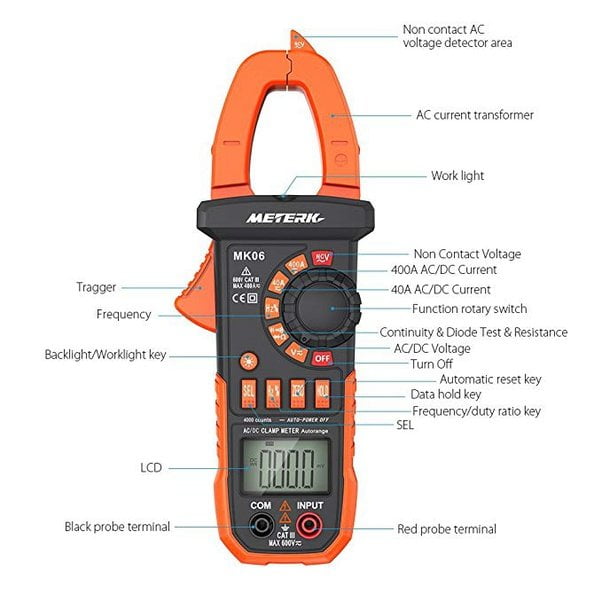Whether you are looking for, or want to know Is there any electrical device ,which measure electrical current of current carrying conductor without having to make physical contact or Disconnecting electrical system.
Answer :- yes,there is an electrical device called clamp meter which did the work of measuring electrical current without physical contact.
This electrical equipment do not only measure current but also following these parameters :-
- AC current or DC village
- AC voltage or DC village
- Resistance
- Capacitance
- Temparature and more
If you any doubt or any problems related this Topic then I am 100 percent sure that, after reading this 7 minute article on this topic you have no any Doubt.
In this Article you will learn :-
- What is it or it’s definition ?
- What does it measures ?
- What is it’s use ?
- Why it is most popular ?
- It’s Types
- What is it’s Range ?
- Advantage or Disadvantage
- Working principle
- How large current it measure ?
Must read:-Ammeter
What is Clamp Meter ?
The Clamp Meter is an electrical device with jaws open to allow the electrical conductor to be clamped around it.
It allows the current in a conductor to be measured without having to make physical contact with it, or to disconnect it for insertion through the probe.
Or
The clamp meter is an electrical tester which combines a simple digital multimeter with a current sensor.
Clamps measure current & probes measure voltage.
With the hinged “clamp” jaw incorporated into the electrical meter, users can easily clamp around wire, cables and other conductors at any point in the electrical system and check its current without disconnecting it.
An electrical meter with an integrated AC current clamp is known as a clamp meter, a clamp-on ammeter, a tong tester or, colloquially, an amp clamp.

What do Clamp Meters measure ?
- It measure any of these or we can say it is used to measure following parameters :-
- AC current,
- AC and DC voltage,
- Resistance,
- continuity, and, with some models,
- DC current,
- Capacitance
- Temperature
- Frequency and more
- Usually, it measure to the nearest tenth of a unit (rather than the milli-units,you find in a full-function multimeter), making them suitable for electrical work.
Uses of Clamp meter
For industrial appliances, industrial devices, residential / commercial / industrial electrical systems and commercial / industrial HVAC, clamp meters are used.
We are used it mainly in:
- Service: to repair existing systems on a necessary basis.
- Maintenance: to perform scheduled and preventive maintenance as well as system troubleshooting.
- Installation: to troubleshoot installation problems, perform final circuit tests and supervise apprentice electrical workers while installing electrical equipment.
Why it is most popular ?
Clamp meters became popular tools mainly because of two reasons:
- 1.Safety :- Clamp meters enable electricians to avoid the old-school method of cutting into a wire and inserting the check of one meter leads into the circuit to take an in-line current calculation. In a test the jaws of a clamp meters should not contact a conductor.
- Convenience :-The circuit carrying current doesn’t need to be shut off during a measurement — a big boost in efficiency.
Why clamp meter preferred
- Clamp meters are preferred because it measure of high level currents.
- DMMs will not be able to measure 10 A of current for more than 30 seconds without risking meter damage.
Range of Clamp meter
The clamp meters offer a minimum current range from 0 A to 100 A. Many models have a range of up to 600 A. Others are up to 999 A or 1400 A, and some plug-in clamp attachments, such as the iFlex ®, will reach up to 2500 A.
Types of Clamp meter
- Current transformer clamp meters: measure only alternating current (ac).
- Hall Effect clamp meters: measure both alternating current and direct current (ac and dc).
- Flexible clamp meters: employ a Rogowski coil; measure ac only; good for measuring in tight spaces
Advantage
One of the main advantage of this equipment is that the measurement of a high value current can be taken even without turning off / shutting the circuitry being checked.
Disadvantage
The only drawback of this test equipment (Clamp meters or Tong tester) is the tong-tester’s accuracy is considerably low.
Why use clamp meters ?
- As part of troubleshooting, industrial conditions frequently call for simultaneous measurement, many of these users carry two meters: one to measure electrical current, and one to measure voltage.
- A clamp meter is a simple and versatile diagnostic device for electricians to find out whether an electrical system or piece of equipment is not working properly.
How to Operate Clamp Meter (Tong Tester)
- Switch ON the clamp meter (Tong tester).
- In order to avoid any damage to the circuit, only a higher scale value should be selected. Decrease the scale of the reading selector slowly if the current is less.
- Clip ON the ammeter around each cable in turn and measure the current.
Clamp meter how it works
Current Transformer Clamp Meter (Tong Tester) – Operating Principle and How it works
The Tong Tester (Clamp Meter) which is based on current transformer consists of two clamps made of ferrite iron.
These clamps are wrapped separately with Copper Coils.
Together they form a magnetic core that actually does the measurements.
The electromagnetic principle states that “when a current flows through a conductive material, it causes the generation of magnetic-flux in it.
Now, let us assume that the primary arm of the transformer is the conducting material through which the current is passing.
A magnetic field is generated in it, due to the movement of the current. Once the tong tester arm is placed for measurement it acts as the transformer’s secondary winding.
The iron core of the tong tester arm concentrates the primary winding magnetic field (i.e., conductor) and thus due to electromagnetic-induction, a current is proportion to the primary-current.
This tong tester arm is connected to the measurement circuitry which, in turn, finally provides the current reading.
The measuring unit for the measurements of magnetic field is also known as magnetic flux.
It is denoted by the Greek letter Phi’ (Φ)
Current clamp meters based on transformers only respond to the ac waveforms.
How large currents can be measured using clamp meter?
The induced magnetic field in clamp meter arms is directly proportional to the number of turns in the secondary winding.
Since the number of turns in the secondary winding is much more than the number of turns in the primary winding wrapped around the core, a very small amount of current is applied to the input of the measuring unit.
Let us take a example for better understanding .
If the number of turns in the secondary winding is 100 then the current produced in the secondary winding is 1/100th of the current that flows through the primary winding.
This means that only 1 amp will reach the input of the meter to measure 100 amp of current.
Using this technique, even large currents with clamp meter can easily be measured by increasing the number of turns in the secondary winding.
Hall Effect Clamp Meters – Operating Principle and How it works
Hall Effect clamp meters are capable of measuring both DC and AC currents.
Similar to the current transformer Clamp Meters, the Hall Effect clamp meter also consists of two clamps made up of Ferrite Iron.
However, these clamps are not wrapped in copper wires, as in the case of current transformer clamp meters.
In the Hall Effect clamp meter, the magnetic field induced by the current flowing through the conductor is concentrated in the gap(s) (one or more) of the core when the clamps close around the conductor.
You can notice the existence of Gap when you carefully see the tips of the clamps in the figure above.
The Gap in the Clamp core creates an air pocket where the magnetic field is concentrated when both of the Hall Effect clamp meter clamps meet / close.The gap also ensures that the core is not saturated by limiting the magnetic flux.
Inside the gap, there is a small semiconductor component known as the Hall Effect Sensor.This Hall Effect Sensor is not visible because it is covered by plastic molding.The Hall Effect Sensor is a special transducer that can vary its output voltage depending on the magnetic field increases or decreases due to current flowing in the conductor.
This property of the Hall Effect sensor is used for measuring current.The voltage produced by the Hall Effect Sensor for representing the current flowing through the conductor is further amplified and scaled.
The Hall Effect Clamp Meter can also measure DC current because the core is also capable of concentrating DC magnetic fields.
However, these clamp meters need to be zeroed when measuring the current to prevent the presence of errors due to Earth’s magnetic field or any other source of magnetic field in near vicinity.
In this Article,I have written answers to all Questions arises on this Topic which I have learned from my faculty or from books.
Anything I missed ? Please write it down in the comment section and don’t forget to share it, because sharing is caring.
You can check price




